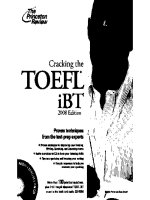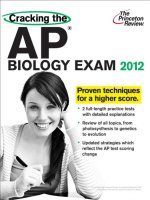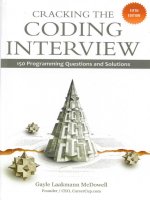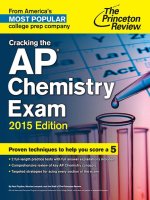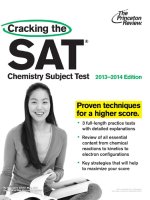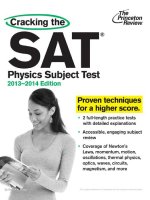Cracking the AP chemistry exam, 2018 edition (gnv64)
Bạn đang xem bản rút gọn của tài liệu. Xem và tải ngay bản đầy đủ của tài liệu tại đây (24.81 MB, 421 trang )
Editorial
Rob Franek, Editor-in-Chief
Casey Cornelius, VP Content Development
Mary Beth Garrick, Director of Production
Selena Coppock, Managing Editor
Meave Shelton, Senior Editor
Colleen Day, Editor
Sarah Litt, Editor
Aaron Riccio, Editor
Orion McBean, Associate Editor
Penguin Random House Publishing Team
Tom Russell, VP, Publisher
Alison Stoltzfus, Publishing Director
Jake Eldred, Associate Managing Editor
Ellen Reed, Production Manager
Suzanne Lee, Designer
The Princeton Review
555 W. 18th Street
New York, NY 10011
E-mail:
Copyright © 2017 by TPR Education Worldwide, LLC. All rights reserved.
Published in the United States by Penguin Random House LLC, New York, and in Canada by Random House of Canada, a
division of Penguin Random House Ltd., Toronto.
Terms of Service: The Princeton Review Online Companion Tools (“Student Tools”) for retail books are available for only the
two most recent editions of that book. Student Tools may be activated only twice per eligible book purchased for two
consecutive 12-month periods, for a total of 24 months of access. Activation of Student Tools more than twice per book is in
direct violation of these Terms of Service and may result in discontinuation of access to Student Tools Services.
Trade Paperback ISBN 9781524710033
Ebook ISBN 9781524710392
AP and Advanced Placement Program are registered trademarks of the College Board, which is not affiliated with The
Princeton Review.
The Princeton Review is not affiliated with Princeton University.
Editor: Selena Coppock
Production Artist: Craig Patches
Production Editor: Liz Rutzel, Beth Hanson
Cover art by JG Photography / Alamy Stock Photo
Cover design by Susan Lee
v4.1
a
Acknowledgments
The Princeton Review would like to give special thanks to Nick Leonardi for his hand in
revising and updating this title to better prepare students for the AP Chemistry Exam. Nick
would like, in turn, to thank the AP Chemistry teacher community from the College Board
forums, and his parents, who, despite not knowing chemistry, have contributed more to his
success than anybody else.
Contents
Cover
Title Page
Copyright
Acknowledgments
Register Your Book Online!
Part I: Using This Book to Improve Your AP Score
Preview Activity: Your Knowledge, Your Expectations
Your Guide to Using This Book
How to Begin
Part II: Practice Test 1
Practice Test 1: Answers and Explanations
Part III: About the AP Chemistry Exam
The Structure of the AP Chemistry Exam
Overview of Content Topics
How AP Exams Are Used
Other Resources
Designing Your Study Plan
Part IV: Test-Taking Strategies for the AP Chemistry Exam
1
How to Approach Multiple-Choice Questions
2
How to Approach Free-Response Questions
Part V: Content Review for the AP Chemistry Exam
3
Big Idea #1: Atoms, Elements, and the Building Blocks of Matter
The Periodic Table
Moles
Coulomb’s Law
Photoelectron Spectroscopy
Predicting Ionic Charges
Periodic Trends
Chapter 3 Questions
Chapter 3 Answers and Explanations
4
Big Idea #2: Bonding and Phases
Bonds Overview
Ionic Bonds
Metallic Bonds
Covalent Bonds
Intermolecular Forces
Vapor Pressure
Lewis Dot Structures
Kinetic Molecular Theory
Maxwell-Boltzmann Diagrams
Effusion
The Ideal Gas Equation
Dalton’s Law
Deviations from Ideal Behavior
Density
Solution Separation
Chapter 4 Questions
Chapter 4 Answers and Explanations
5
Big Idea #3: Chemical Reactions, Energy Changes, and Redox Reactions
Types of Reactions
Chemical Equations
Gravimetric Analysis
Enthalpy
Energy Diagrams
Catalysts and Energy Diagrams
Oxidation States
Oxidation-Reduction Reactions
Galvanic Cells
Electrolytic Cells
Chapter 5 Questions
Chapter 5 Answers and Explanations
6
Big Idea #4: Chemical Reactions and Their Rates
Rate Law Using Initial Concentrations
Rate Law Using Concentration and Time
Collision Theory
Beer’s Law
Reaction Mechanisms
Catalysts
Chapter 6 Questions
Chapter 6 Answers and Explanations
7
Big Idea #5: Laws of Thermodynamics and Changes in Matter
Heat and Temperature
State Functions
Enthalpy of Formation, ΔHºf
Bond Energy
Hess’s Law
Enthalpy of Solution
Thermodynamics of Phase Change
Calorimetry
Heating Curves
Entropy
Gibbs Free Energy
Free Energy Change, ΔG
ΔG, ΔH, and ΔS
Voltage and Favorability
Chapter 7 Questions
Chapter 7 Answers and Explanations
8
Big Idea #6: Equilibrium, Acids and Bases, Titrations, and Solubility
The Equilibrium Constant, Keq
Le Châtelier’s Principle
Changes in the Equilibrium Constant
The Reaction Quotient, Q
Solubility
Acids and Bases Definitions
pH
Acid Strengths
Neutralization Reactions
Buffers
Indicators
Titration
Chapter 8 Questions
Chapter 8 Answers and Explanations
9
Laboratory Overview
Part VI: Practice Test 2
Practice Test 2: Answers and Explanations
Register Your Book Online!
1
Go to
2
You’ll see a welcome page where you can register your book using the
following ISBN: 9781524710392.
3
After placing this free order, you’ll either be asked to log in or to answer a
few simple questions in order to set up a new Princeton Review account.
4
Finally, click on the “Student Tools” tab located at the top of the screen. It
may take an hour or two for your registration to go through, but after that,
you’re good to go.
PrincetonReview.com/cracking
If you have noticed potential content errors, please e-mail
with the full title of the book, its ISBN number (located
above), and the page number of the error.
Experiencing technical issues? Please e-mail with the
following information:
• your full name
• e-mail address used to register the book
• full book title and ISBN
• your computer OS (Mac or PC) and Internet browser (Firefox, Safari, Chrome,
etc.)
• description of technical issue
Once you’ve registered, you can…
• Find any late-breaking information released about the AP Chemistry Exam
• Take a full-length practice SAT and ACT
• Get valuable advice about the college application process, including tips for writing a
great essay and where to apply for financial aid
• Sort colleges by whatever you’re looking for (such as Best Theater or Dorm), learn
more about your top choices, and see how they all rank according to The Best 382
Colleges
• Access comprehensive study guides and a variety of printable resources, including
answer bubble sheets, the periodic table, and a list of equations to review
• Check to see if there have been any corrections or updates to this edition
Look For These Icons Throughout The Book
Online Articles
More Great Books
College Advisor App
Proven Techniques
Applied Strategies
Part I
Using This Book to Improve Your AP Score
PREVIEW ACTIVITY: YOUR KNOWLEDGE, YOUR
EXPECTATIONS
Your route to a high score on the AP Chemistry Exam depends a lot on how you plan to use this book.
Please respond to the following questions.
1. Rate your level of confidence about your knowledge of the content tested by the AP
Chemistry Exam:
A.
B.
C.
D.
Very confident—I know it all
I’m pretty confident, but there are topics for which I could use help
Not confident—I need quite a bit of support
I’m not sure
2. Highlight your goal score for the AP Chemistry Exam.
5
4
3
2
1
I’m not sure yet
3. What do you expect to learn from this book? Highlight all that apply to you.
A.
B.
C.
D.
A general overview of the test and what to expect
Strategies for how to approach the test
The content tested by this exam
I’m not sure yet
YOUR GUIDE TO USING THIS BOOK
This book is organized to provide as much—or as little—support as you need, so you can use this
book in whatever way will be most helpful to improving your score on the AP Chemistry Exam.
• The remainder of Part I will provide guidance on how to use this book and help you
determine your strengths and weaknesses
• Part II of this book contains Practice Test 1, its answers and explanations, and a scoring
guide. (Bubble sheets can be downloaded here.) We strongly recommend that you take
this test before going any further, in order to realistically determine:
• your starting point right now
• which question types you’re ready for and which you might need to practice
• which content topics you are familiar with and which you will want to carefully
review
Once you have nailed down your strengths and weaknesses with regard to this exam, you can focus
your test preparation, build a study plan, and be efficient with your time.
• Part III of this book will
• provide information about the structure, scoring, and content of the AP Chemistry
Exam
• help you to make a study plan
• point you towards additional resources
• Part IV of this book will explore
• how to attack multiple-choice questions
• how to write high-scoring free-response answers
• how to manage your time to maximize the number of points available to you
• Part V of this book covers the content you need for your exam.
• Part VI of this book contains Practice Test 2, its answers and explanations, and a
scoring guide. (Bubble sheets can be downloaded here.) If you skipped Practice Test 1,
we recommend that you do both (with at least a day or two between them) so that you can
compare your progress between the two. Additionally, this will help to identify any
external issues: If you get a certain type of question wrong both times, you probably need
to review it. If you only got it wrong once, you may have run out of time or been
distracted by something. In either case, this will allow you to focus on the factors that
caused the discrepancy in scores and to be as prepared as possible on the day of the test.
You may choose to use some parts of this book over others, or you may work through the entire book.
This will depend on your needs and how much time you have. Let’s now look how to make this
determination.
HOW TO BEGIN
1. Take a Test
Before you can decide how to use this book, you need to take a practice test. Doing so will
give you insight into your strengths and weaknesses, and the test will also help you make an
effective study plan. If you’re feeling test-phobic, remind yourself that a practice test is a tool
for diagnosing yourself—it’s not how well you do that matters but how you use information
gleaned from your performance to guide your preparation.
So, before you read further, take AP Chemistry Practice Test 1 starting at this page of this
book. Be sure to do so in one sitting, following the instructions that appear before the test.
2. Check Your Answers
Using the answer key on this page, count how many multiple-choice questions you got right
and how many you missed. Don’t worry about the explanations for now, and don’t worry
about why you missed questions. We’ll get to that soon.
3. Reflect on the Test
After you take your first test, respond to the following questions:
• How much time did you spend on the multiple-choice questions?
• How much time did you spend on each long form free-response question? What about
each short form free-response question?
• How many multiple-choice questions did you miss?
• Do you feel you had the knowledge to address the subject matter of the free-response
questions?
• Do you feel you wrote well organized, thoughtful answers to the free-response
questions?
• Circle the content areas that were most challenging for you and draw a line through the
ones in which you felt confident/did well.
• Big Idea #1: Atoms, Elements, and the Building Blocks of Matter
• Big Idea #2: Bonding and Phases
• Big Idea #3: Chemical Reactions, Energy Changes, and Redox Reactions
• Big Idea #4: Chemical Reactions and their Rates
• Big Idea #5: Laws of Thermodynamics and Changes in Matter
• Big Idea #6: Equilibrium, Acids and Bases, Titrations and Solubility
4. Read Part III of this Book and Complete the Self-Evaluation
As discussed previously, Part III will provide information on how the test is structured and
scored. As you read Part III, re-evaluate your answers to the questions on the previous page.
You will then be able to make a study plan, based on your needs and time available, that will
allow you to use this book most effectively.
5. Engage with Parts IV and V as Needed
Notice the word engage. You’ll get more out of this book if you use it intentionally than if
you read it passively, hoping for an improved score through osmosis.
The strategy chapters will help you think about your approach to the question types on this
exam. Part IV will open with a reminder to think about how you approach questions now and
then close with a reflection section asking you to think about how/whether you will change
your approach in the future.
The content chapters are designed to provide a review of the content tested on the AP
Chemistry Exam, including the level of detail you need to know and how the content is tested.
You will have the opportunity to assess your mastery of the content of each chapter through
test-appropriate questions.
6. Take Test 2 and Assess Your Performance
Once you feel you have developed the strategies you need and gained the knowledge you
lacked, you should take Test 2, which starts at this page of this book. You should do so in one
sitting, following the instructions at the beginning of the test.
When you are done, check your answers to the multiple-choice sections on this page. See if a
teacher will read your answers to the free-response questions and provide feedback.
Once you have taken the test, reflect on what areas you still need to work on, and revisit the
chapters in this book that address those deficiencies. Through this type of reflection and
engagement, you will continue to improve.
7. Keep Working
After you have revisited certain chapters in this book, continue the process of testing,
reflecting, and engaging with the second test. Each time, consider what additional work you
need to do and how you will change your strategic approach to different parts of the test.
Part II
Practice Test 1
Click here to download the PDF version.
AP® Chemistry Exam
SECTION I: Multiple-Choice Questions
DO NOT OPEN THIS BOOKLET UNTIL YOU ARE TOLD TO DO SO.
At a Glance
Total Time
1 hour and 30 minutes
Number of Questions
60
Percent of Total Grade
50%
Writing Instrument
Pencil required
Instructions
Section I of this examination contains 60 multiple-choice questions. Fill in only the ovals for numbers 1 through 60 on your answer sheet.
CALCULATORS MAY NOT BE USED IN THIS PART OF THE EXAMINATION.
Indicate all of your answers to the multiple-choice questions on the answer sheet. No credit will be given for anything written in this
exam booklet, but you may use the booklet for notes or scratch work. After you have decided which of the suggested answers is best,
completely fill in the corresponding oval on the answer sheet. Give only one answer to each question. If you change an answer, be sure
that the previous mark is erased completely. Here is a sample question and answer.
Sample Question
Chicago is a
(A) state
(B) city
(C) country
(D) continent
Sample Answer
Use your time effectively, working as quickly as you can without losing accuracy. Do not spend too much time on any one question. Go
on to other questions and come back to the ones you have not answered if you have time. It is not expected that everyone will know the
answers to all the multiple-choice questions.
About Guessing
Many candidates wonder whether or not to guess the answers to questions about which they are not certain. Multiple-choice scores are
based on the number of questions answered correctly. Points are not deducted for incorrect answers, and no points are awarded for
unanswered questions. Because points are not deducted for incorrect answers, you are encouraged to answer all multiple-choice
questions. On any questions you do not know the answer to, you should eliminate as many choices as you can, and then select the best
answer among the remaining choices.
CHEMISTRY
SECTION I
Time—1 hour and 30 minutes
INFORMATION IN THE TABLE BELOW AND ON THE FOLLOWING PAGES MAY BE USEFUL IN ANSWERING
THE QUESTIONS IN THE SECTION OF THE EXAMINATION
1.
In a saturated solution of Na3PO4, [Na+] = 0.30 M. What is the molar solubility of Na3PO4?
(A)
(B)
(C)
(D)
2.
0.10 M
0.30 M
0.60 M
0.90 M
When some LiCl is dissolved in water, the temperature of the water increases. This means that:
(A) the strength of the intermolecular forces between the water molecules is stronger than the bond energy within the
LiCl lattice
(B) the attraction of the lithium ions to the negative dipoles of the water molecules is weaker than the attraction of the
chloride ions to the positive dipoles of the water molecules
(C) breaking the bonds between the lithium and chloride ions is an exothermic process
(D) the strength of the ion-dipole attractions that are formed exceeds the lattice energy in LiCl
Use the following information to answer questions 3-6
A student titrates some 1.0 M HCl into 20.0 mL of methylamine (CH3NH2), a weak base which only accepts a single proton. The
following titration curve results:
3.
What is the concentration of the methylamine?
(A)
(B)
(C)
(D)
4.
0.50 M
0.75 M
1.0 M
1.25 M
What is the approximate pKb for methylamine?
(A) 3.5
(B) 5.5
(C) 10.5
(D) 12.5
5.
The buffer region of this titration is located:
(A)
(B)
(C)
(D)
Below 3.0 mL
Between 3.0 mL and 14.0 mL
Between 14.0 mL and 16.0 mL
Above 16.0 mL
6.
The methylamine is replaced by 20.0 mL of sodium hydroxide of an identical concentration. If the sodium hydroxide is
titrated with the 1.0 M HCl, which of the following options accurately describes the pH levels at various points during the
titration when compared to the pH levels at the same point in the HCl/methylamine titration?
7.
The formate ion, HCO2–, is best represented by the Lewis diagram below. Each bond is labeled with a different letter.
What is the bond order for each bond?
X
Y
Z
(A)
1
1
2
(B)
2
2
1
(C)
1
1.5
1.5
(D)
1.33
1.33
1.33
Ag+ (aq) + 2 NH3 (aq) ⇌ Ag(NH3)2+ (aq)
8.
The reaction above is at equilibrium in a closed system. Which of the following will happen immediately when water is
added?
(A)
(B)
(C)
(D)
9.
The rate of the reverse reaction will increase.
Both ions will increase in concentration, while the NH3 decreases in concentration.
The reaction will shift to the right.
Nothing will happen; adding water does not cause any changes to the equilibrium system.
The two products above are created from a reaction involving CO and NO2, as drawn in the answer options below. Which
of the following options indicates a viable orientation of both reactant molecules prior to the collision? (Note: the arrows
indicate the direction each molecules is moving prior to the collision)
(A)
(B)
(C)
(D)
CXHY (g) + O2 (g) → CO2 (g) + H2O (g)
10.
When the above unbalanced reaction occurs at STP, 1.5 L of CO2 and 1.0 L of H2O are created. What is the empirical
formula of the hydrocarbon?
(A)
(B)
(C)
(D)
CH2
C2H3
C2H5
C3H4
2 H2O2 (aq) → 2 H2O (l) + O2 (g)
11.
For the decomposition of hydrogen peroxide, which element (if any) is being reduced, and which is being oxidized?
(A)
Oxidized
Reduced
Hydrogen
Oxygen
